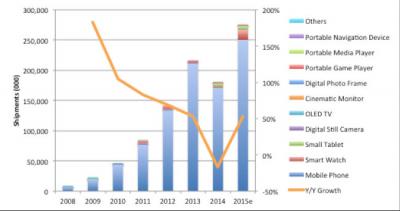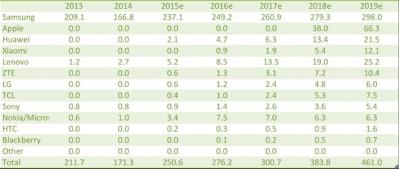The OLED Association posted an interesting article, summarizing 2015 and giving its projection for 2016 and onwards. So first of all, they conclude that 2015 was a great year for the OLED display industry, with shipments up 53% over 2014 to reach almost 275 million units. AMOLED Revenues grew to almost $13 billion - up 40% over 2014.

The growth was mostly due to Samsung Display's effort to commercialize flexible OLED displays for mobile phones and the expansion of AMOLED customer beyond Samsung Electronics. LG Display also contributed to the OLED display market, and the OLED association estimates the LG sold over 400,000 OLED TVs. They also say that they shipped around 14,000 flexible OLEDs, but they probably mean around 14 million - as that about makes sense for the Apple Watch.

The association makes some interesting projections in 2016. They see Apple actually making a public announcement that they contracted Samsung and LG to supply OLED displays for the iPhone 8, and production will begin in Q4 2018. It will be strange to see Apple announcing this deal as they have not even yet confirmed that the Watch uses an OLED. Apple will require around 30 million panels in 2018 and 70 million in 2019 (this means that not all new iPhones will adopt OLEDs). Apple will negotiate with JDI over OLED supply in 2019 or 2020. JOLED, however will be ready to make tablet-sized OLEDs by the end of 2016.
AS LG aims to supply OLED smartphone displays, it will switch to a phosphorescent green material in 2017. Both Samsung and LG will move forward with flexible OLED capacity expansion - getting ready for Apple that will probably use a flexible display. Samsung will show a foldable smartphone, but only as a prototype or "near-production" model.
Other OLED makers will not fare so well. The OLED-A estimates that AUO will exit the OLED smartphone market, and the Chinese makers will not be able to ship large volumes yet. Innolux will continue to built its 6-gen OLED fab, but will not start mass production yet.
Turning to OLED TVs, the OLED-A sees LG as the only OLED TV maker, producing over 1 million TVs in 2016. Prices for 55" and 65" panels will become competitive with high end LCDs - with a 10% to 15% premium. Samsung will not announce an OLED TV but will continue to develop the technology - and will be ready to launch the first TV in 2017. Samsung's 2017 OLEDs will feature HDR and 8K resolution. Interestingly the OLED-A sees Samsung adopting a transparent graphene electrode, a top-emission architecture, an RGBW pixel arrangement and an IGZO backplane. Soluble OLEDs will not be adopted as the lifetime performance is still not good enough
BOE will not be ready to produce OLED TVs in 2016, but it will deliver sample panels to TV makers in China - and will still consider whether to commit to a Gen-8.5 production fab.


Is Samsung's suggested RGBW architecture just a rebranding of LG's WOLED patented process?